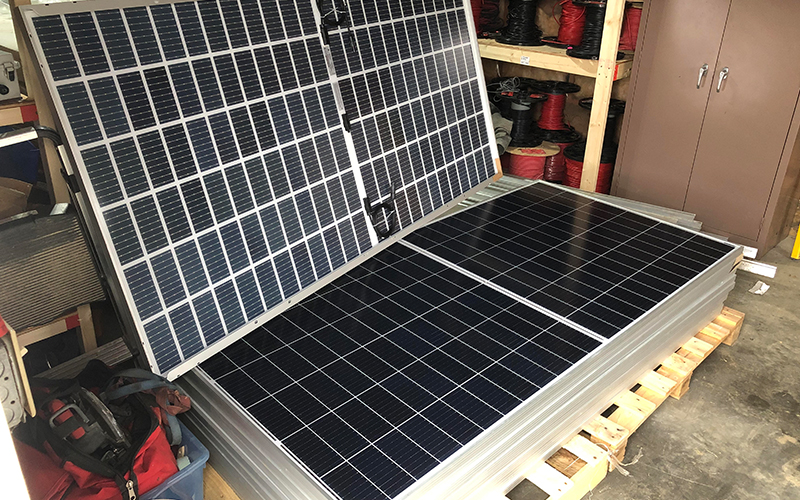At Aegis Renewable Energy in Waitsfield, president and CEO Nils Behn said the company has been busy this spring and is doing a lot of work in Massachusetts, Rhode Island and Connecticut.
Asked about new advances in solar and alternative energy, he offered a few thoughts. The first has to do with bifacial (two-faced) solar panels.
“These have gotten a lot of traction in the last one and a half to two years. They have panels on the front and back and the reflected light off the back side (or snow side during the Vermont winters) will generate power,” he said.
“This technology is of particular importance for Vermont and northeastern states because when like last February, for example, most of our projects made no power at all. They got snowed on and frozen over. With bifacials in that situation you’d get 10% of what your normally do. That’s pretty exciting,” Behn said.
HYBRID INVERTERS
Most inverters provide standard net metering by allowing solar installations to export power to the grid. Behn said that hybrid inverters are becoming more common these days.
What a hybrid inverter does is allow energy to be stored in a battery bank, keeping it topped off at all times, before sending power to the grid. What the battery can’t store goes to the grid. If the grid goes down, the battery provides power.
“You can get a hybrid inverter even without the battery initially and then add it afterward. It has that ability,” Behn said, noting that when the grid goes down the hybrid inverter automatically switches to providing power through the battery bank to the house or building it serves.
NOT YET, BUT COMING
One fun development that is probably five years out will occur when almost everyone is driving vehicles with enormous batteries.
“Then you’ll start to see vehicle to grid and vehicle to home transmission. You’ll charge your car at home from an array and the grid. If the power goes out, you can supply power for the house with your car battery,” he said.
Behn said that the Tesla Model 3 has a battery bank 10 times bigger than what a typical house would use and that would power a house for a week or more.
Behn is also excited about the development of drones with thermal imaging capabilities. Aegis has recently purchased a high-resolution quadcopter with a thermal camera on it that can see heat variations in the environment.
“That allows us to inspect solar arrays and see heat anomalies so we can identify a problem before it causes a bigger problem,” Behn said.
As bright as the future for renewables is, Behn cautioned against recent changes in the state’s Public Utility Commission regulations that reduced net metering rates by 2 cents per kilowatt hour and a proposal to lower the net metering rates again, by 1 cent this September. He pointed out that when rates are 16 cents per kilowatt hour, that is a significant hit.
“When the PUC values net metering, they don’t consider any of the societal benefits of solar power, the greenhouse gas reductions, the economic stimulus it brings to the states, the jobs it creates, taxes and lease payments,” he said.
Further, he said Vermont utilities are meeting their alternative energy requirements by purchasing renewable credits from Hydo Quebec whose 40-year-old dams and facilities emit greenhouse gases and are not adding any new renewables to the mix.
“That’s not doing anything to reduce our state’s carbon footprint. In fact, it is reducing the state’s appetite for renewable energy which is stopping the state from taking meaningful action to reduce carbon emissions,” he said.
Because of these state policies, Aegis is focusing on projects in nearby states, while still building those already permitted in Vermont before the change in net metering rates.
Unless the state changes its policies, he predicts a significant loss of jobs in the alternative energy industry in the state.
Aegis Renewables is in the Kingsbury Industrial Park in Waitsfield and employs 10 people full time.







